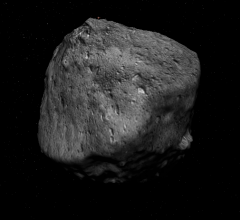Difference between revisions of "162173 Ryugu"
(Ryugu.) |
(Added to wikitable.) |
||
| (8 intermediate revisions by the same user not shown) | |||
| Line 1: | Line 1: | ||
| − | {{Addon | + | {{Addon |
|1=[https://www.orbiter-forum.com/threads/delta-v-novel.41431/#post-613690 Ryugu-00.zip] | |1=[https://www.orbiter-forum.com/threads/delta-v-novel.41431/#post-613690 Ryugu-00.zip] | ||
| − | |2=francisdrake | + | |2=[[List of add-ons by francisdrake|francisdrake]] |
|3=00 | |3=00 | ||
|4=Orbiter 2016 | |4=Orbiter 2016 | ||
| Line 31: | Line 31: | ||
|width="30%"|Inclination (i)||align="right" width="30%"|0.102690286265441 radian<br>(5.88372°) | |width="30%"|Inclination (i)||align="right" width="30%"|0.102690286265441 radian<br>(5.88372°) | ||
|- | |- | ||
| − | |width="30%"|Longitude of the ascending node (LAN, ☊)||align="right" width="30%"| | + | |width="30%"|Longitude of the ascending node (LAN, ☊)||align="right" width="30%"|0 radian<br>0° |
| − | |||
| − | |||
| − | |||
| − | |||
|- | |- | ||
!bgcolor="lightsteelblue" colspan="2"|Rotational Elements | !bgcolor="lightsteelblue" colspan="2"|Rotational Elements | ||
|- | |- | ||
| − | |width="30%"|Sidereal Rotation Period||align="right" width="50%"| | + | |width="30%"|Sidereal Rotation Period||align="right" width="50%"|87133.4717273712 seconds<br>(1.00848925610383 days) |
|- | |- | ||
|width="30%"|Sidereal Rotation Offset||align="right" width="50%"|0 | |width="30%"|Sidereal Rotation Offset||align="right" width="50%"|0 | ||
| − | |||
| − | |||
|- | |- | ||
!bgcolor="lightsteelblue" colspan="2"|Selected physical parameters | !bgcolor="lightsteelblue" colspan="2"|Selected physical parameters | ||
|- | |- | ||
| − | |width="30%"|Mean radius||align="right" width="30%"| | + | |width="30%"|Mean radius||align="right" width="30%"| 450 m |
|- | |- | ||
| − | |width="30%"|Mass||align="right" width="30%"| | + | |width="30%"|Mass||align="right" width="30%"|7.24641539269111×10<su>10</sup> kg |
|- | |- | ||
| − | |width="30%"| | + | |width="30%"|Equatorial gravity||align="right" width="30%"| 0.0032 m/s<sup>-10</sup> |
|- | |- | ||
| − | |width="30%"| | + | |width="30%"|Orbital speed at surface||align="right" width="30%"|0.1034 m/s |
|- | |- | ||
| − | |width="30%"|Escape velocity||align="right" width="30%"| | + | |width="30%"|Escape velocity||align="right" width="30%"| 0.000147 m/s |
|- | |- | ||
| − | |width="30%"|Gravity at surface|| | + | |width="30%"|Gravity at surface||align="right" width="30%"|Ryugu 1%<br>Sun 99% |
|- | |- | ||
| − | |width="30%"|Note||align="right" width="30%"|*Elements given are from | + | |width="30%"|Note||align="right" width="30%"|*Elements given are from Ryugu.cfg file. |
|} | |} | ||
| + | |||
| + | '''162173 Ryugu''' or in [[Orbiter]] simply '''Ryugu''' is near-Earth object of the Appolo group of small bodies, discovered by Lincoln Near-Earth Asteroid Research astronomers on 10 May 1999. | ||
| + | |||
| + | Ryugu is an add-on by francisdrake released in 2023 on the forum, and is compatible with Orbiter 2016. In Orbiter, Ryugu orbits the [[Sun]] with a semi-major axis of 1.19 AU, inclination of 0.1027 radians, and eccentricity of 0.19. Its gravity is very weak, even at the surface, in OrbitMFD, Ryugu's gravity is 1% and the Sun's gravity is 99%. A person could literally jump at greater than escape speed. Rotation is just over a day. | ||
| + | |||
| + | The landing surface (hard radius) is well inside the mesh/texture, so, landing on Ryugu places the spacecraft well inside the body. | ||
| Line 67: | Line 67: | ||
Ryugu orbit.png|<center>Orbits of the inner planets showing the orbit of Ryugu in white. From Wikimedia commons.</center> | Ryugu orbit.png|<center>Orbits of the inner planets showing the orbit of Ryugu in white. From Wikimedia commons.</center> | ||
</gallery> | </gallery> | ||
| + | |||
| + | {{SolarSystem}} | ||
| + | |||
| + | [[Category:Articles|Ryugu]] | ||
| + | [[Category:Celestial body add-ons|Ryugu]] | ||
| + | [[Category:Solar System|Ryugu]] | ||
| + | [[Category:Near-Earth objects|Ryugu]] | ||
Latest revision as of 12:02, 28 May 2024
|
Project home: Ryugu-00.zip |
162173 Ryugu or in Orbiter simply Ryugu is near-Earth object of the Appolo group of small bodies, discovered by Lincoln Near-Earth Asteroid Research astronomers on 10 May 1999.
Ryugu is an add-on by francisdrake released in 2023 on the forum, and is compatible with Orbiter 2016. In Orbiter, Ryugu orbits the Sun with a semi-major axis of 1.19 AU, inclination of 0.1027 radians, and eccentricity of 0.19. Its gravity is very weak, even at the surface, in OrbitMFD, Ryugu's gravity is 1% and the Sun's gravity is 99%. A person could literally jump at greater than escape speed. Rotation is just over a day.
The landing surface (hard radius) is well inside the mesh/texture, so, landing on Ryugu places the spacecraft well inside the body.
Gallery[edit]
| edit The Solar System | |
|---|---|
| Central star |
Sun (Sol) |
| Planets |
Mercury - Venus - Earth - Mars - Jupiter - Saturn - Uranus - Neptune |
| Natural satellites |
Moon - Phobos - Deimos - Io - Europa - Ganymede - Titan - more... |
| Add-ons |
Planets - Dwarf Planets - Small objects - Natural satellites - Alternative star systems |

